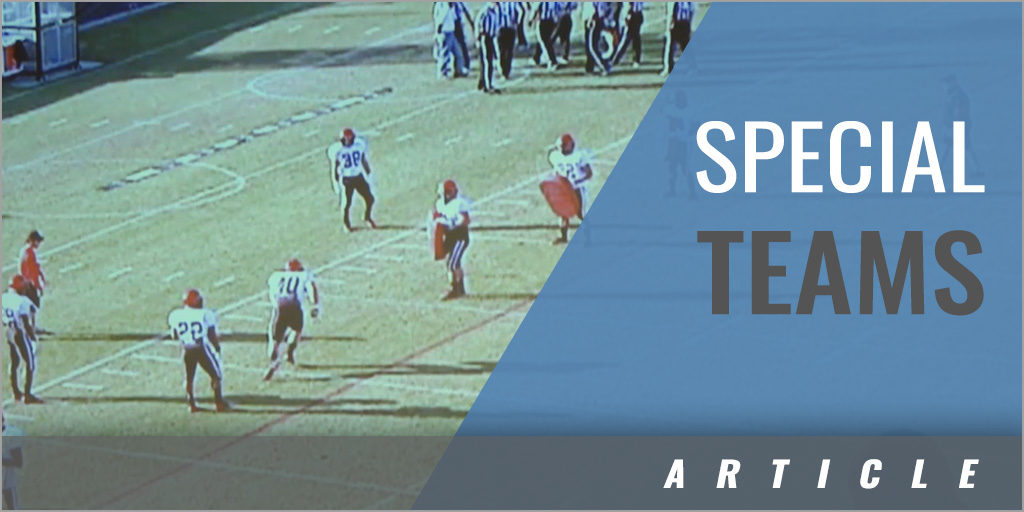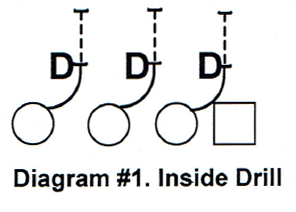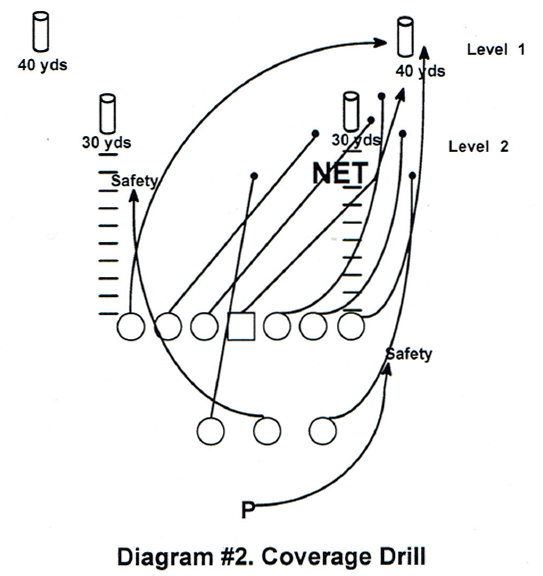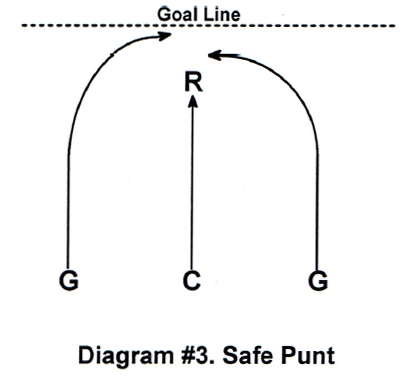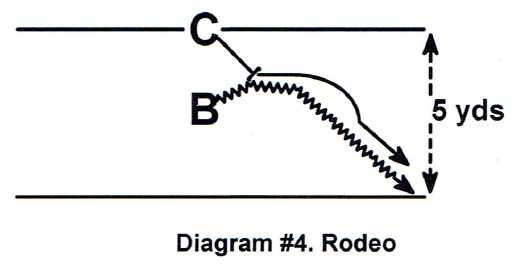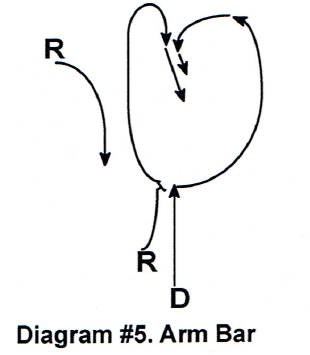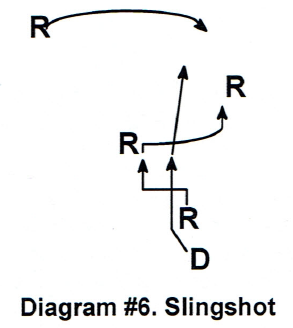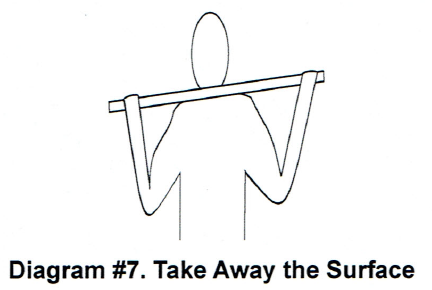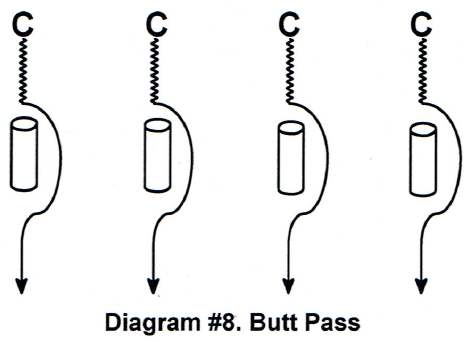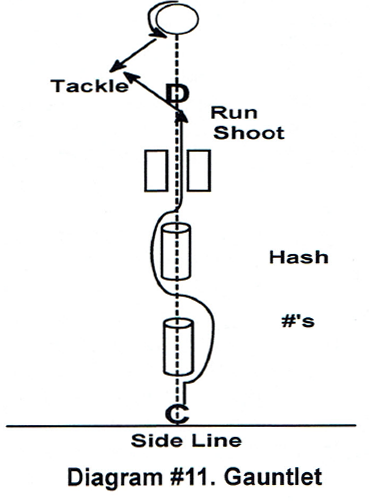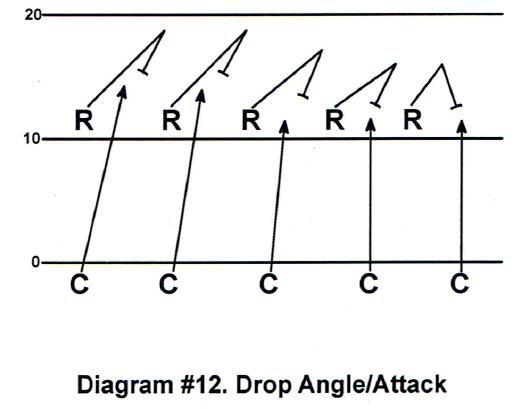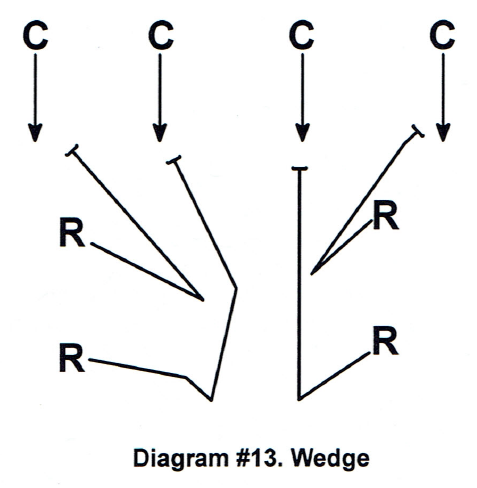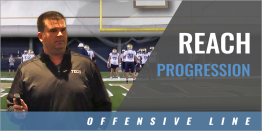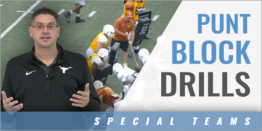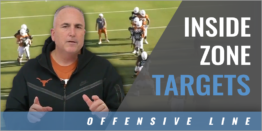|
By: Dean Hood, Univ. of Kentucky Originally Published in: 2018 Nike Coach of the Year Clinic Manual, by Earl Browning Provided by: Nike Coach of the Year Thank you very much. I have four kids that are 16, 14, 12, and 10. When they were smaller we used to play a game using an apple. I would ask them how many seeds was in the apple. They would make all kinds of guesses from seven to two seeds in the apple. Depending on the size of the apple when we cut it open there were a different numbers of seeds in each apple. If you made a good guess, the number of seeds was somewhere around seven seeds. That is kind of like coaching. How many kids are we as coaches going to influence? There are an infinite number. Whether you are a position coach, head coach, or how long you coach, the number is like the seeds in that apple. There are an infinite number of players. However, the real question is how many apples are in those seeds? This is my 30th year of coaching. I do not know how much longer I will be doing this. There is a finite number of kids that I had the opportunity to influence. If I can help one kid be a better dad having coached him, it is worth it. If I can help one kid be a better husband having coached him, it is worth it. That one kid may be coming out of a fatherless home. He could become the trailblazer that breaks the mold and becomes a good father. He is there for his family. That lays the ground work for his son and the grandson. It goes on and on in an infinite number of people. How many apples are in those seeds? We as coaches have an incredible influence on our players. I talked at the FCA breakfast this morning and told a story about my 16 year old son. Two years ago when he was 14 he went to play middle school football. I have played catch with him since he was a young kid. I told him when he caught the ball to make sure he tucked it away. I had to remind him time and again to tuck the ball away. He came home after the second or third middle school practice and wanted to go outside and play catch. We went outside and I threw him the ball. He grabbed it and quickly tucked it away. I threw it to him again and he did the same thing. I congratulated him for catching the ball and tucking it away. He told me that his coach told him to tuck the ball away when we catch it because it is really valuable. You have to possess the ball. What the coach says is really, really powerful. I went to the Black Mountain coach's camp many, many years ago. One of buddies came by and wanted to know if I wanted to go hear Billy Graham speak. He said it was nine miles away and wanted to know if I wanted to go meet him. I told him I did. We spent about an hour talking to him. When we got up to leave, he told us we had a golden opportunity to change the world. We have an incredible influence on today's youth. I have some stats on fatherless kids. Fatherless kids have quadrupled since 1960. Kids that come out of fatherless homes are 10 times more likely to sell drugs. Five times more likely to commit suicide. Seventy-two times likely to be killed. They make up 72 percent of the teenage murders in the country. Eighty percent are drug dependent or alcohol dependent and are housed in some kind of rehab center. They make up 71 percent of teen pregnancy. We have an opportunity as coaches to change that. We can become that father figure of the kids we coach. I am 54 years old and have coached for 30 years. I have never had a player call me up and tell me thanks for teaching him how to tackle. I hope when you get to be 54 that you are talking about the influence you have on young people to be a good father, husband, good neighbors, and a good leader in their community. I am here to talk about special teams. I love coaching special teams and have been involved with coaching it for almost all those 30 years. I have coached it in (some shape or fashion for my entire career. When I became a head coach, I took over the special teams and did that exclusively. This past year, I was hired at the University of Kentucky to coach special teams. I think the important part of special teams play is not the scheme, but the drill work. I think regardless of the scheme, you can use these drills with your special teams. Punt Coverage: The first drill I want to show you is the "inside drill." (Diagram #1) It does not matter what scheme you use at some point, you will have to block a defender inside of you. We align three punt protectors on the right side with two yards between them. On the other side aligned in the gaps are three defenders with shields. The coverage teams launch point is to their right and their blocking assignment is to their right.
The blockers want to step with their outside foot and give ground to the inside. They want to cut off the defender. They must get their helmet inside the defender. They step off the outside foot, give ground on the first step inside, and cut off the defender. In the drill we want the blockers to get square on the dummies with their helmet inside. The hand placement is in the breastplate of the defender. They step, cut off, punch, extend the arm (lock out), and rip through the defender to the inside. The next part of the drill moves the dummies to the outside of the blockers. They are now blocking an outside block. Their launch point is inside and their blocking assignment is outside of him. We use a technique called "over-up-inside." The blocker steps over with his outside foot to position step on the defender. His second step is up with the inside foot. He wants to punch with his inside hand, lock out his arm, and escape to the inside of the defender. As the blocker steps over, he wants to keep his helmet on the inside of the defender. When he steps up with his inside foot, he delivers a punch with his inside hand. The next drill is the "coverage drill." (Diagram #2) We set up the protection unit and cover the punt. If we are punting out of the middle of the field, we place two dummies to the right and two dummies to the left. If the kick is to the right, we align one dummy at 30 yards on the hash mark. The second dummy is 10 yards deeper between the numbers and the hash marks. We set up the other side the same way.
There are three components to our coverage. That is the reason for the two dummies. The first component are the gunners. They are going straight to the football and want to leverage the ball from the outside. The right gunner is going for the second dummy and is leveraging the dummy to the right. The left gunner is attacking the dummy on the left side. They should beat everyone down the field. The long snapper is part of that first attack wave. He is coming down the middle of the second dummy. The first level of our coverage has three guys going for the ball. The second level of the coverage is called the "net." The first man in the net is five yards from the returner. The second coverage man is 10 yards from the returner and the third man is 15 yards from the returner. When we talk about 5, 10, and 15 yards, we are making reference to width. We have the same configuration on the other side of the coverage. We have three guys in the first level and six players in the net at the second level of coverage. The third component is the safeties. The quarterback of the punt team is the player calling the cadence and making adjustments. He is usually the middle player in the shield. He is the safety opposite the direction of the kick. The punter is the other safety and goes to the side of the kick. When we practice the drill we have defenders with dummies that move up and down the line of scrimmage. Their job is to hold up a coverage player. When that happens, the player with the free release replaces the player that is being held up in the net line up. If the held up player was the inside net runner, the player outside of him because the 5 yard player. The held up player switches and becomes the 10 yard net player. We can never predict who will get off the line of scrimmage first. However, the net must be replaced from the inside out. That means we may have two players exchange positions, but we must have the net in proper order. The next thing is the safe punt. This occurs when the ball is in the gray zone. The defense is not sure the offense is going to punt the ball. They do not bring their returners on the field. They play their regular defense and put a return man deep. We drill this with the center and the gunners. (Diagram #3) We snap the ball and the center and gunners cover the ball.
The center's job is to go nose-to-nose with the returner. The first and second coverage people are going around the returner and attempting to keep the ball from getting into the end zone. The gunner wants to be able to see the returner and the punted ball. The second coverage player ignores the return man and gets between him and the goal line. He can catch the ball in the air if he can find it. The center is responsible for the returner. If he tries to run the ball the center has to make the play. If the ball is muffed, he wants to get on the ball. The first coverage guy down has to see the ball and returner in case he decides to return the ball. The college rule says the ball has to break the plane of the end zone for there to be a touch back. The player can be in the end zone as long as the ball does not break the plane. The gunners must see the ball as well as the returner. That keeps them from being drawn to a return that is faking a fair catch hoping the ball goes into the end zone. The net is coming down the field, but we do not use them in this drill. If you want to work on your gunners keeping the ball out of the end zone. Line them up and throw footballs on the ground at them. The football takes some odd bounces and you can prepare them for it. Punt Return: On our punt return we actually spend more time on individual work than we do on team work. When we partner the players up we want similar types going against one another. We do not want a fast player going against a slow player. When we work our hold up drill, we are going one-on-one. We want 8 seconds on the punt hold up, but if one second is all we can get that is one more second for our return man. The return blocker has to get his hands inside on the coverage defender's breastplate with a wide base. When the defender moves the blocker wants to shuffle his feet and stay in front of the defender. We want to be as aggressive as we can be. There are very few holding penalties given in the first five yards of the return. We break our blocking down as the first five yards, second five yards, and the last five yards. Most of the penalties come in the last five yards of the coverage. We call the first five yards the "rodeo", the blocker is trying to hold up the defender. (Diagram #4)
The blocker wants to flatten the coverage defender in the first five yards. He wants to ride him and run him wide. We want to be aggressive and hold up the coverage guy. If we can widen the defender and run him out of bounds that is what we want to do. The rodeo technique is like a defensive back in press man coverage. The second part of the block is called the "arm bar or slingshot." Those are the two techniques we use as we run down the field with the defender after the rodeo. Those techniques are all about the blocker position and the punt returner. The second five yards the blocker has to determine whether he should use an arm bar or slingshot. That decision will be made on the blocker's relationship to the punt returner. The arm bar technique is the same technique used by a defensive back in man-coverage. (Diagram #5) The blocker after the rodeo opens his hips as the defender starts to cover the punt. The blocker has his outside hand on the defender pushing him to the outside. If the returner is inside of the blocker, he continues to use the arm bar and ride the defender wider and we sprint down the field. The blocker is sprinting inside the defender with his arm on him. He is not allowing the defender to come inside and is pushing him wider as they go down the field.
If the defender gets width and continues down the field, the blocker lets him go and sprints to the returner. He squares to the outside and faces the defender. He keeps the defender to the outside and runs on the inside of the defender as the returner brings the ball inside of the blocker. He wants to use his body to shield the return player. The inside hand is the critical hand in the return. The blocker cannot allow the defender to get over the top of his block. He has to keep him outside. The next technique is called "slingshot." (Diagram #6) This occurs after the rodeo and the defender ends up on the inside of the blocker. That is not a good situation because the returner is inside. The defender is inside the blocker. The blocker reaches around the defender, grabs his inside hip, and slingshots himself to the inside of the blocker.
That puts the blocker inside the defender. However, he is not going to be able to square up on the defender as he did with the arm bar. We use what we call "spray paint." The blocker is going to block the defender with his back. It is like blocking out on a rebounder in basketball. He wants to turn his hips as if blocking out on a rebound, so the defender cannot get inside to the return man. When you do the drills start with a stationary return man. That means the blocker can arm bar all the way down and not worry about where the ball is. When we go forward with the drill, we move the returner. The blocker started out with an arm bar because the returner was on his inside. However, the return man got outside the blocker and he is no longer on the inside of the blocker. The blocker now has to slingshot on the defender to get between the defender and the return man. We drill the outside and inside blocks going at the same time. The outside blocker uses his arm bar and keeps the defender outside. The inside blocker will have to slingshot to get into his proper position on the return man. When we do this drill we have officials involved to call blocks in the back. Most of those blocks occur in the last five yards of the return. If the blocker does not block and runs by the defender doing what we call spray painting we can get away with that. We work this part of the drill live so they can understand what a block in the back is. The blocker has to be under control so he does not overrun the defender in the spray paint technique. He has to make contact then turn his hips to get his back to the defender. If he overruns the defender, he opens the door for the tackle. In the punt return game not every blocker is going solo on the block. We will double team the gunners or good coverage personnel. The direction of the punt and the speed of the coverage team effect where the double teams will occur Kickoff Coverage: The next aspect of the kicking game is kickoff coverage. The first aspect of coverage is to "take away the surface." This is in reference to avoiding the attempted block of a return blocker. We describe it as getting skinny and taking the surface of the body away. We do that by turning the shoulders as you go by a blocker. We drill this on yard lines running across the field. The coverage team works down those lines at half speed. (Diagram #7)
They carry a broom stick across their shoulders with their arms holding the stick at the ends. As they run down the line, they rotate their shoulders to the right and left sides. When they rotate the shoulders, it takes the body surface away and makes us skinny to the blockers. We run the entire width of the field on the yard line and return down the next yard line. They rotate their shoulders at the hash marks going and coming. They rotate the shoulders four times going across the field and returning. The reason for the broom stick is to make them move both shoulders. That reduces the surface of the body for the blocker. After we run with the broom stick across the shoulders, we shift it down to the waist and do the same thing. The next point to kick off coverage is passing the blocker on the face side or butt side. This is a coaching point we emphasized this year and I think it really helped us. The coverage team wants to beat the front line coverage blockers on the butt side. As the blockers retreat, they turn their shoulders to run back. The coverage team wants to pass the blocker on the butt side of the blocker's tilt. We drill this on stand up dummies. (Diagram #8) We have four lines of coverage personnel and four stand up dummies. The coverage team is going to skinny past the dummies on the left side. They want to rotate their shoulders past the dummies then get to a stack position on the dummy.
When we talk about stacking the blocker, we are making reference to the position of the coverage team. As they reduce the surface and get past the blocker, they want to get the blocker directly behind them. That keeps the blocker from recovering his position and block the coverage. We place the blocker in a stacked position behind the coverage. That way they must block in the back or let the coverage man go. After the coverage team beats the first line blockers, they are in position to tackle the ball carrier or take on a second level blocker with the hands. You must take on second level blockers with the hands because you are too close to the ball to run by the blocker. We have to take on the blocker with our hands, disengage, and move to the returner. The next drill is the face side coverage. (Diagram #9)
If the coverage team comes to the face side of the blocker that means the blocker wants to block the coverage in the direction he is facing. On the face side, the coverage must execute what we call a U-turn. We are not stacking the blocker, we are making a U-turn around the blocker to get into the area where the return is coming. To add a variation to the drill, we add dummy holders with shield dummies instead of the standup dummies. The coach stands behind the coverage team and tells the dummy holders which way to turn. If we are covering butt side of the return, it makes the coverage adjust their techniques as they come down. That is simply going from a stationary dummy to a movement key. To go further with the progression, we add tackling wheels to the drill. (Diagram #10) The coverage team begins and covers the face side of the blocker. They skinny by on the face side of the dummy holder. They make the U-turn and we roll the tackling wheels. The coverage team tackles the wheels.
We divide our kick off into segments of the field. The first part of the kickoff is a speed and read segment. This is the face and butt side area with first line blockers. This is the avoid zone. We are not taking on blockers we are running past them. When we get to the second level blocker, we cannot avoid them because we are too close to the ball. We have to take on the blocker. We call it "run and shoot." The coverage team runs to the blocker, shoots his hands, and runs his feet pushing the blocker back. From here he is going to find the ball and react to it. He disengages from the blocker and makes the tackle. To drill this we use the "gauntlet drill." The coverage man runs straight down a yard line. There are two dummies spaced so that he has to use the face/butt technique or avoid the dummies. We have two shield holders standing together. The coverage has to break through the double team. The next level is the second level blocker. The coverage man runs and shoots his hands. The last part of the drill is the wheel roller. We roll the wheel one way or the other. The coverage man disengages and tackles the rolling wheel.
I probably should have showed this first. It is called "talking the line." All we are doing is practicing our run up to the ball. We want to be as close to the line as possible without getting off sides. You must practice that so you are full speed as you cover down field. Kickoff Return: The first thing we start with is what we call "board work." We use short shoulder width 2 X 4 boards. The return team gets in a four point stance with the board in their hands on the ground. We simply push the board straight down the field. The next part of the drill is to turn the board to the right and then to the left. It is doing a bear crawl with a board in your hands. We are working on driving the feet. We progress from the boards to kneeling and working on the punch and lockout. The next progression is to stand and do the same thing. We are working on rolling the hips, striking, and finishing with the feet. The most important thing on the kickoff return is the drop angle of the front line. If your drop angle is wrong, all the work you did with the boards and lockout drill went for nothing. The purpose of the drop angle is to get the blocker between the coverage team and the returner. The first thing the front line has to do is see the ball. It is like a pre-snap read. We coach them as to the position of the ball as to what type of kick is coming. We can tell if the kick is going right, left, or skied. Most kicks go to the right side. If I am a left side player, my drop angle is a more drastic angle than the right side drops. He cannot get into his drop angle until he knows the ball is kicked off. He has to guard against the on-side kick or a specialty kick. A specialty kick would be a pooch, skied, or some other type of unconventional kick. The blocker has to see the flight of the ball to know that his pre-snap read was correct. The ball is going right. The blocker has to think ball, flight, and man in his sequence. Man in the sequence means the blocker had to stay between his blocking assignment and the returner. In the film room, when the player settles I hit the pause button. If the player is between his assignment and the returner he has done his job. Everything that happens after that is technique work and aggressive play. When we drill the drop angle we cut the area from 30 yards to 10 yards. (Diagram #12) When they get 10 yards, they settle. When we settle the shoulders square up to the coverage team. That is important. By being square the blocker takes away the face side and butt side escape or avoid technique by the coverage. We do this drill during the season to emphasize how important the drop angle is. The blockers have to settle and attack the coverage personnel. They cannot sit and wait for the coverage to come to them.
The coverage has a full head of steam and will run over you or around you. You have to meet force with force. The depth of the drop of the front line players will depend on the returner or the depth of the kick. If the kick is short, the front line has to shorten up their drop. You have to give them rules, but you have to make them aware that there are exceptions to the rules. When we work on the attack part of the kickoff return, we work with smaller units. Instead of five blockers, we may work with three. They work their drops and then attack the coverage using their drive techniques. If the blocker needs to go in the opposite direction then he is originally turned, we use the speed turn. If the blocker is to the left of the ball and the ball is kicked to his left, he has to face to the right to see the ball. To get there we use a speed turn instead of trying to open up the hips and flip in the other direction. It is the speed turn the defensive back uses in pass coverage. Depending on what your scheme is, we use a drill to set the wedge. While the front line blockers are working on their attack drill, the back line players are working on the wedge. We have five front line blockers and four wedge blockers. (Diagram #13) The four wedge blockers come together and work on whatever scheme you devise. You could be involved with a double team scheme or kick out blocking technique. What we work on is the spacing and timing of the wedge.
It always helps to have a good kick returner. Fellows are there any questions you would like to ask? I appreciate your attention. The University of Kentucky doors are always open. Come see us. |
